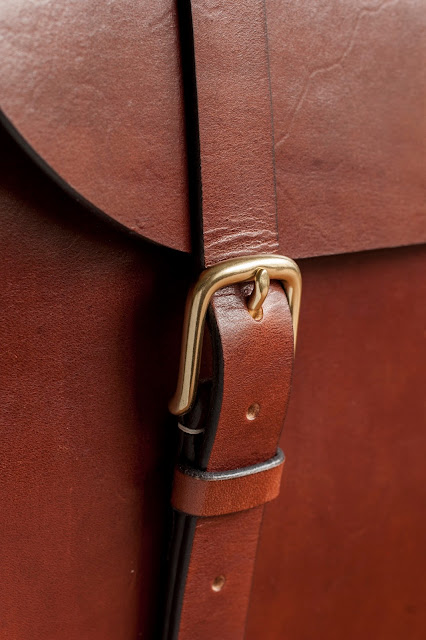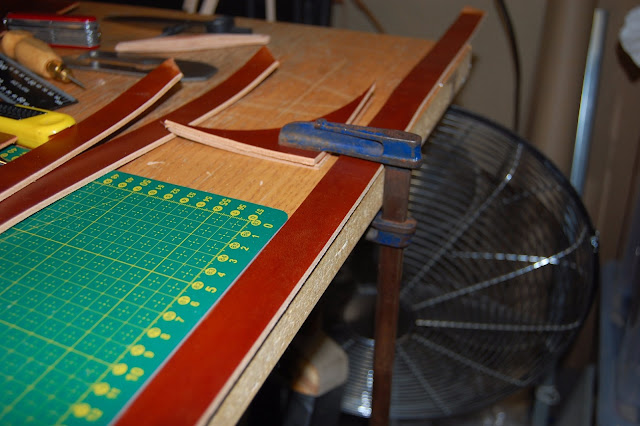First the straps need to have the edges done. This means bevelling and burnishing.
My setup for this is to hold them in place by pressing them up against my cutting board. To prevent the straps from falling on the ground I place a clamp on the tablewhich it slides under.
The beveling is easy as long as your tool is sharp. You should be able to take of the entire length of the strap in one piece.
The straps are long so there is plenty of time practicing your burnishing skills! Also you should burnish one end of the strap and on the short shoulder strap you should do both ends. Make holes for the buckles and snap hooks according to the pattern if you use the same size hardware as I do. With the holes in place you should dye them so that they don't stand out too much.
Make the lines for the pricking iron and mark the holes.
I skive the last 4 cm of the straps and dye around the edges especially near the bend. I use black because I had in my marker. If your are very particular you should technically use the same dye as was used for the rest of the leather.
You can now wet the bends and wrap it around the buckles and let them dry before sewing. You could chose to glue them together depending on how you plan to sew them.
The belt keepers are cut with a strap cutter and then skived down from 3,5 to 2,5mm. I don't have a skiving machine so I made my own very primitive one. I wouldn't use it if I had to skive a lot but for these few pieces it got the job done. Be VERY careful around this thing. It will cut you up in a heart beat if you mess around!
Burnish the edges and you can cut it to size using the technique shown in the pictures. I'm always amazed of how short it needs to be but the method works every time.
The ends of the straps need to be cut to a point. I chose to simply cut the sides in a bit.
Also the strap needs holes. I find a distance of 2,5 cm between each hole suitable. The pattern shows where the holes should start but you should double check that this fits your bag as well - remember, every bag is unique.
When cutting straps begin slowly making sure that the edges are flush against each other.
Before cutting the straps make sure that width is correct.
Burnish the ends.
Make marks for the buckle holes.
Position your punch carefully and hit it with a hammer.
What a nice hole.
Unfortunately I do not have a punch long enough so I reposition it and hit it
again
It is very hard to make holes perfect this way but you will not notice this.
It is a bit hard to see but I put a small mark where I want the pricking holes to begin. The mark is made right where the rounding of the hole ends.
All marks in place. At this point you should dye the holes.
The same is done for the snap hooks but without the holes.
Skiving the ends.
All done.
Wet it before bending.
Use a Q-tip to dye but do it before wetting the leather.
Not much but the devil is in the details.
Also dye the skived areas where one might be able to see.
Hardware line up
Now let it dry.
Home made skiving jig. Luckily the cutting mat hat the right thickness.
Gently push in the strip of leather and pull it in and out in a cutting motion.
At some point you will be able to grasp it with a pliers and pull it. I used a bone folder to help keep the strip in place. Be careful when pulling making sure you hands are always safe.
The end did deform a bit but the rest is okay.
Ready to cut to length.
Wrap it around.
Then place another piece of strap right up against the belt loop.
Scribe a line next to the it.
You cant really see the line but it is there.
Mark and scribe lines.
Cut it.
Bevel the edges on the front.
And the back.
Edges burnished.
I use this template of thin clear plastic with holes every 2,5 cm to mark the holes.
Holes marked
Holes made.
My setup for this is to hold them in place by pressing them up against my cutting board. To prevent the straps from falling on the ground I place a clamp on the tablewhich it slides under.
The beveling is easy as long as your tool is sharp. You should be able to take of the entire length of the strap in one piece.
The straps are long so there is plenty of time practicing your burnishing skills! Also you should burnish one end of the strap and on the short shoulder strap you should do both ends. Make holes for the buckles and snap hooks according to the pattern if you use the same size hardware as I do. With the holes in place you should dye them so that they don't stand out too much.
Make the lines for the pricking iron and mark the holes.
I skive the last 4 cm of the straps and dye around the edges especially near the bend. I use black because I had in my marker. If your are very particular you should technically use the same dye as was used for the rest of the leather.
You can now wet the bends and wrap it around the buckles and let them dry before sewing. You could chose to glue them together depending on how you plan to sew them.
The belt keepers are cut with a strap cutter and then skived down from 3,5 to 2,5mm. I don't have a skiving machine so I made my own very primitive one. I wouldn't use it if I had to skive a lot but for these few pieces it got the job done. Be VERY careful around this thing. It will cut you up in a heart beat if you mess around!
Burnish the edges and you can cut it to size using the technique shown in the pictures. I'm always amazed of how short it needs to be but the method works every time.
The ends of the straps need to be cut to a point. I chose to simply cut the sides in a bit.
Also the strap needs holes. I find a distance of 2,5 cm between each hole suitable. The pattern shows where the holes should start but you should double check that this fits your bag as well - remember, every bag is unique.
When cutting straps begin slowly making sure that the edges are flush against each other.
Before cutting the straps make sure that width is correct.
The strap slides under the clamp.
The cutting mat holds the strap in place while beveling. The other hand should hold on top of the strap.
It might look like the piece has broken off but in fact it is still intact.
Here you see the piece in its complete length.
Ready for burnishing.Burnish the ends.
Make marks for the buckle holes.
Position your punch carefully and hit it with a hammer.
What a nice hole.
Unfortunately I do not have a punch long enough so I reposition it and hit it
again
It is very hard to make holes perfect this way but you will not notice this.
It is a bit hard to see but I put a small mark where I want the pricking holes to begin. The mark is made right where the rounding of the hole ends.
All marks in place. At this point you should dye the holes.
The same is done for the snap hooks but without the holes.
Skiving the ends.
All done.
Wet it before bending.
Use a Q-tip to dye but do it before wetting the leather.
Not much but the devil is in the details.
Also dye the skived areas where one might be able to see.
Hardware line up
Now let it dry.
Home made skiving jig. Luckily the cutting mat hat the right thickness.
Gently push in the strip of leather and pull it in and out in a cutting motion.
At some point you will be able to grasp it with a pliers and pull it. I used a bone folder to help keep the strip in place. Be careful when pulling making sure you hands are always safe.
The end did deform a bit but the rest is okay.
Ready to cut to length.
Wrap it around.
Then place another piece of strap right up against the belt loop.
Scribe a line next to the it.
You cant really see the line but it is there.
Mark and scribe lines.
Cut it.
Bevel the edges on the front.
And the back.
Edges burnished.
I use this template of thin clear plastic with holes every 2,5 cm to mark the holes.
Holes marked
Holes made.











































Appreciate you taking the time to put this together...
ReplyDelete